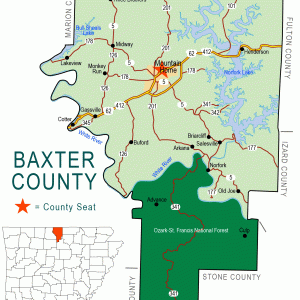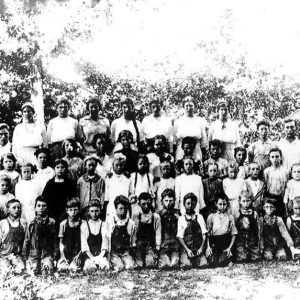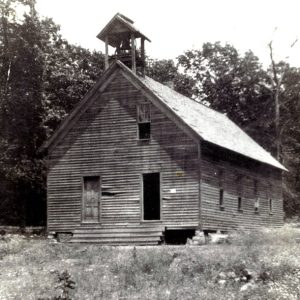calsfoundation@cals.org
Monkey Run (Baxter County)
The small community of Monkey Run is located in a narrow valley on the western border of modern-day Baxter County. During its heyday in the early 1920s, it was home to a number of thriving businesses and as many as seven zinc mining operations.
The settlement reportedly came into existence with the establishment of the nearby Pilgrim’s Rest Baptist Church in 1872. Early families who helped settle the area included the Hodges, Reeds, Staffords, and Messicks. By the early 1900s, a school had been established and a few businesses were in operation.
A name change came sometime shortly after its founding as Pilgrim’s Rest. At least three versions of the story regarding the name change exist, though all concern a local storekeeper. One story relates that a group of young boys playing around the store abruptly awakened the storekeeper, who chased the boys away while yelling “watch them monkeys run.” A second version states that the boys were referring to the storekeeper in saying, “Make the old monkey run and chase us.” The third version concerns the shopkeeper and his young sweetheart. The story goes that he had to frequently restock his store because he showered her with so many gifts. Locals referred to his many trips to obtain new merchandise by saying, “There goes the old monkey on his run.”
With America’s entry into World War I, zinc mining became big business. At one time, seven such area mines were in operation, with a company called The Gold Standard employing the largest number of miners. Ore mined in Monkey Run was transported by wagon to Cotter (Baxter County) for shipment. The community reached its peak in the early 1920s and 1930s. During this time, it was home to four stores, three blacksmith shops, a cotton gin, a grist mill, a molasses mill, a Masonic lodge, an Odd Fellows lodge, a doctor, and a telephone exchange. At one time, the cotton gin processed as many as 250 bales each year, with the ashes and sawdust created in the process sold as fertilizer.
The closing of the mines by the late 1920s and the coming of the Great Depression saw the community experience a serious decline. By the mid-1930s, only one store was left. Still, the local school remained, and a popular town baseball team known as the Monkey Runners was a major distraction from the hard times.
One brief moment of recovery arose with a proposal to establish a tomato canning factory. The company interested in opening the factory attempted to convince the residents to change the name of the community to Pleasant Valley. Owners believed that marketing a product hailed as “Canned in Pleasant Valley, Arkansas” would boost sales. While shipments of tomatoes were sent to the community, the factory never opened.
For a time in the 1930s, the production of illegal alcohol by outfits such as the Bruce Creek Bootleggers and the Gold Standard Gang was big business. The secretive operations were shut down when government agents were led to the hidden moonshine stills by a local girl.
Population continued to decline during World War II, when many of the young men left for service in the military. The community saw further decline in the 1950s, and by 1964 only the Four Sisters Store, operated by the Messick family, remained. It closed in 1968. Today, only the abandoned building remains. In 1969, when the school was consolidated with Cotter’s schools, it was the last remaining one-room school house in Baxter County.
Today, only a few residential properties remain, along with a cemetery. A short-lived annual reunion of town residents began in the early 2000s. The last gathering was held in 2004.
For additional information:
History & Families, Baxter County, Arkansas. Mountain Home, AR: Baxter County Historical and Genealogical Society, 2003.
Holeman, Lu. “Small Towns in Ozarks: Monkey Run.” Life in the Ozarks, July 1, 2006, pp. 10, 31, 32.
Huddleston, J. A. “A Place Called Monkey Run.” Arkansas Democrat, January 5, 1964, p. 3.
Messick, Mary Ann. The History of Baxter County, 1873–1973. Mountain Home, AR: Mountain Home Chamber of Commerce, 1973.
Mike Polston
CALS Encyclopedia of Arkansas
 Baxter County Map
Baxter County Map  Pilgrim's Rest Class of 1916
Pilgrim's Rest Class of 1916  Pilgrim's Rest School
Pilgrim's Rest School 




My dad (Charles Marler) lived in Monkey Run as a young boy. My great-grandfather donated the land for the Pilgrims Rest Cemetery. My grandfather (Henry Marler) owned a blacksmith shop in Monkey Run.
My dad Jim Fisk is buried in the Monkey Run Cemetery; he was a war veteran and Mason.
I was very young when my parents lived in Monkey Run, but I do remember the old rock mill where they made tombstones and sold them. I also remember the one-room schoolhouse and the ferry to get out of Mountain Home. All my relatives lived around each other–the Smith clan.
My grandparents owned property (80 acres) in Monkey Run years ago (1930 to 1955, I think): Freddie Thomas and Ema Smith, also Archie Tillman Smith and Dee Smith. My grandmother was related to some Youngers who lived in that area, too. If you have any information concerning them, could you please contact the encyclopedia or post a comment with this entry?